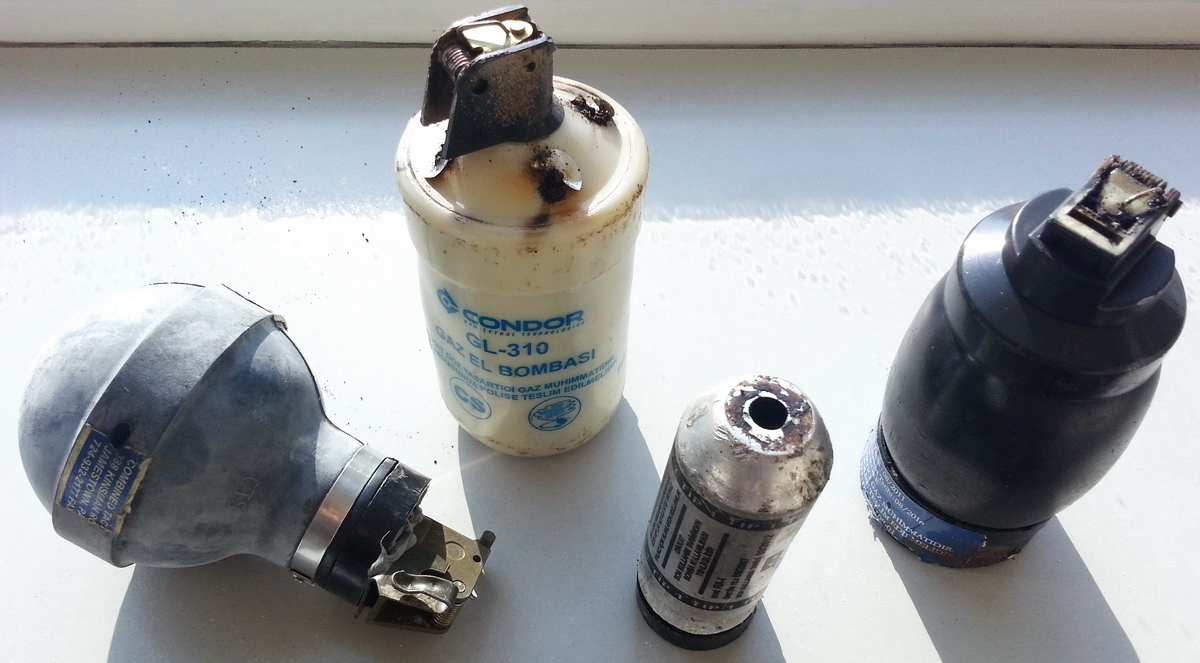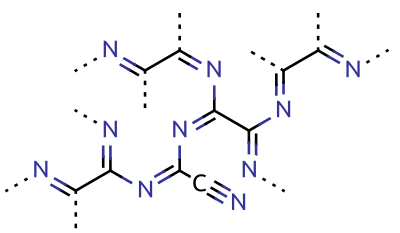|
Malononitrile
Malononitrile is an organic compound nitrile with the formula . It is a colorless or white solid, although aged samples appear yellow or even brown. It is a widely used building block in organic synthesis. Preparation and reactions It can be prepared by Dehydration reaction, dehydration of cyanoacetamide. This method is mainly practiced in China where environmental rules are lax. Most commonly malononitrile is produced by the gas-phase reaction of acetonitrile and cyanogen chloride: : About 20,000,000 kg are produced annually (2007). Important outlets include the synthesis of thiamine, the drug triamterene and minoxidil, and the dyes disperse Yellow 90 and disperse Blue 354. Malononitrile is relatively acidic, with a Acid dissociation constant, p''K''a of 11 in water. This allows it to be used in the Knoevenagel condensation, for example in the preparation of CS gas: Despite its relative obscurity, Malononitrile is very useful in several reactions, the prime example being a s ... [...More Info...] [...Related Items...] OR: [Wikipedia] [Google] [Baidu] |
Acetonitrile
Acetonitrile, often abbreviated MeCN (methyl cyanide), is the chemical compound with the formula and structure . This colourless liquid is the simplest organic nitrile (hydrogen cyanide is a simpler nitrile, but the cyanide anion is not classed as organic). It is produced mainly as a byproduct of acrylonitrile manufacture. It is used as a polar aprotic solvent in organic synthesis and in the purification of butadiene. The skeleton is linear with a short distance of 1.16 Å. Acetonitrile was first prepared in 1847 by the French chemist Jean-Baptiste Dumas. Applications Acetonitrile is used mainly as a solvent in the purification of butadiene in refineries. Specifically, acetonitrile is fed into the top of a distillation column filled with hydrocarbons including butadiene, and as the acetonitrile falls down through the column, it absorbs the butadiene which is then sent from the bottom of the tower to a second separating tower. Heat is then employed in the separa ... [...More Info...] [...Related Items...] OR: [Wikipedia] [Google] [Baidu] |
CS Gas
The compound 2-chlorobenzalmalononitrile (also called ''o''-chlorobenzylidene malononitrile; chemical formula: C10H5ClN2), a cyanocarbon, is the defining component of the lachrymatory agent commonly referred to as CS gas, a tear gas which is used as a riot control agent, and is banned for use in warfare due to the 1925 Geneva Protocol. Exposure causes a burning sensation and tearing of the eyes to the extent that the subject cannot keep their eyes open, and a burning irritation of the mucous membranes of the nose, mouth and throat, resulting in profuse coughing, nasal mucus discharge, disorientation, and difficulty breathing, partially incapacitating the subject. CS gas is an aerosol of a volatile solvent (a substance that dissolves other active substances and that easily evaporates) and 2-chlorobenzalmalononitrile, which is a solid compound at room temperature. CS gas is generally accepted as being non-lethal. History CS gas was first synthesized by two Americans, B ... [...More Info...] [...Related Items...] OR: [Wikipedia] [Google] [Baidu] |
Acetonitrile
Acetonitrile, often abbreviated MeCN (methyl cyanide), is the chemical compound with the formula and structure . This colourless liquid is the simplest organic nitrile (hydrogen cyanide is a simpler nitrile, but the cyanide anion is not classed as organic). It is produced mainly as a byproduct of acrylonitrile manufacture. It is used as a polar aprotic solvent in organic synthesis and in the purification of butadiene. The skeleton is linear with a short distance of 1.16 Å. Acetonitrile was first prepared in 1847 by the French chemist Jean-Baptiste Dumas. Applications Acetonitrile is used mainly as a solvent in the purification of butadiene in refineries. Specifically, acetonitrile is fed into the top of a distillation column filled with hydrocarbons including butadiene, and as the acetonitrile falls down through the column, it absorbs the butadiene which is then sent from the bottom of the tower to a second separating tower. Heat is then employed in the separa ... [...More Info...] [...Related Items...] OR: [Wikipedia] [Google] [Baidu] |
Pivalonitrile
Pivalonitrile is a nitrile with the semi-structural formula (CH3)3CCN, abbreviated ''t''-BuCN. This aliphatic organic compound is a clear, colourless liquid that is used as a solvent and as a labile ligand in coordination chemistry A coordination complex is a chemical compound consisting of a central atom or ion, which is usually metallic and is called the ''coordination centre'', and a surrounding array of chemical bond, bound molecules or ions, that are in turn known as ' .... Pivalonitrile is isomeric with ''tert''-butyl isocyanide but the two compounds do not exist in chemical equilibrium, unlike its silicon analog trimethylsilyl cyanide. References 5 Tert-butyl compounds {{alkanederivative-stub ... [...More Info...] [...Related Items...] OR: [Wikipedia] [Google] [Baidu] |
Glycolonitrile
Glycolonitrile, also called hydroxyacetonitrile or formaldehyde cyanohydrin, is the organic compound with the formula HOCH2CN. It is the simplest cyanohydrin and it is derived from formaldehyde. It is a colourless liquid that dissolves in water and ether. Because glycolonitrile decomposes readily into formaldehyde and hydrogen cyanide, it is listed as an List of extremely hazardous substances, extremely hazardous substance. In January 2019, astronomers reported the detection of glycolonitrile, another possible Abiogenesis, building block of life among List of interstellar and circumstellar molecules, other such molecules, in outer space. Synthesis and reactions Glycolonitrile is produced by reacting formaldehyde with hydrogen cyanide at near-neutral pH, but with small amounts of catalytic base.Peter Pollak, Gérard Romeder, Ferdinand Hagedorn, Heinz-Peter Gelbke "Nitriles" ''Ullmann's Encyclopedia of Industrial Chemistry'' 2002, Wiley-VCH, Weinheim. Glycolonitrile polymerizes und ... [...More Info...] [...Related Items...] OR: [Wikipedia] [Google] [Baidu] |
Cyanogen
Cyanogen is the chemical compound with the chemical formula, formula . Its structure is . The simplest stable carbon nitride, it is a Transparency and translucency, colorless and highly toxic gas with a pungency, pungent odor. The molecule is a pseudohalogen. Cyanogen molecules are linear molecular geometry, linear, and consist of two CN groups ‒ analogous to diatomic halogen molecules, such as chlorine, Cl, but far less oxidizing. The two cyanide, cyano groups are bonded together at their carbon atoms, though other isomers have been detected. The name is also used for the CN radical, and hence is used for compounds such as cyanogen bromide () (but see also ''Cyano radical''). When burned at increased pressure with oxygen, it is possible to get a blue tinted flame, the temperature of which is about 4800°C (a higher temperature is possible with ozone). It is as such regarded as the gas with the second highest temperature of burning (after dicyanoacetylene). Cyanogen is the anhy ... [...More Info...] [...Related Items...] OR: [Wikipedia] [Google] [Baidu] |
Propanenitrile
Propionitrile, also known as ethyl cyanide and propanenitrile, is an organic compound with the formula CH3CH2CN. It is a simple aliphatic nitrile. The compound is a colourless, water-soluble liquid. It is used as a solvent and a precursor to other organic compounds. Production The main industrial route to this nitrile is the hydrogenation of acrylonitrile. It is also prepared by the ammoxidation of propanol (propionaldehyde can also be used instead):Peter Pollak, Gérard Romeder, Ferdinand Hagedorn, Heinz-Peter Gelbke "Nitriles" in Ullmann's Encyclopedia of Industrial Chemistry 2002, Wiley-VCH, Weinheim. : Propionitrile is a byproduct of the electrodimerisation of acrylonitrile to adiponitrile. In the laboratory propanenitrile can also be produced by the dehydration of propionamide, by catalytic reduction of acrylonitrile, or by distilling ethyl sulfate and potassium cyanide. Applications Propionitrile is a solvent similar to acetonitrile but with a slightly higher boiling p ... [...More Info...] [...Related Items...] OR: [Wikipedia] [Google] [Baidu] |
Aminopropionitrile
Aminopropionitrile, also known as β-aminopropionitrile (BAPN), is an organic compound with both amine and nitrile functional groups. It is a colourless liquid. The compound occurs naturally and is of interest in the biomedical community. Biochemical and medical occurrence BAPN is the toxic constituent of peas from Lathyrus plants, e.g., '' Lathyrus odoratus''. Lathyrism, a disease known for centuries, encompasses 2 distinct entities: a disorder of connective tissue, causing either bone deformity (osteolathyrism) or aortic aneurisms (angiolathyrim). BAPN causes osteolathyrism and angiolathyrism when ingested in large quantities." It can cause osteolathyrism, neurolathyrism, and/or angiolathyrism. It is an antirheumatic agent in veterinary medicine. It has attracted interest as an anticancer agent. Production Aminopropionitrile is prepared by the reaction of ammonia with acrylonitrile.Karsten Eller, Erhard Henkes, Roland Rossbacher, Hartmut Höke "Amines, Aliphatic" in ''Ullma ... [...More Info...] [...Related Items...] OR: [Wikipedia] [Google] [Baidu] |
Acetone Cyanohydrin
Acetone cyanohydrin (ACH) is an organic compound used in the production of methyl methacrylate, the monomer of the transparent plastic polymethyl methacrylate (PMMA), also known as acrylic. It liberates hydrogen cyanide easily, so it is used as a source of such. For this reason, this cyanohydrin is also highly toxic. Preparation In the laboratory, this compound may be prepared by treating sodium cyanide with acetone, followed by acidification: : Considering the high toxicity of acetone cyanohydrin, a lab scale production has been developed using a microreactor-scale flow chemistry to avoid needing to manufacture and store large quantities of the reagent. Alternatively, a simplified procedure involves the action of sodium or potassium cyanide on the sodium bisulfite adduct of acetone prepared ''in situ''. This gives a less pure product, one that is nonetheless suitable for most syntheses. Reactions Acetone cyanohydrin is an intermediate en route to methyl methacrylate. T ... [...More Info...] [...Related Items...] OR: [Wikipedia] [Google] [Baidu] |
Butyronitrile
Butyronitrile or butanenitrile or propyl cyanide, is a nitrile with the formula C3H7CN. This colorless liquid is miscible with most polar organic solvents. Uses Butyronitrile is mainly used as a precursor to the poultry drug amprolium.Peter Pollak, Gérard Romeder, Ferdinand Hagedorn, Heinz-Peter Gelbke "Nitriles" ''Ullmann's Encyclopedia of Industrial Chemistry'' 2002, Wiley-VCH, Weinheim. It also has recognized use in the synthesis of Etifelmine. Synthesis Butyronitrile is prepared industrially by the ammoxidation of ''n''-butanol: :C3H7CH2OH + NH3 + O2 → C3H7CN + 3 H2O Occurrence in space Butyronitrile has been detected in the Large Molecule Heimat The Large Molecule Heimat is a dense gas cloud located in the molecular cloud Sagittarius B2. Many species of molecule, including aminoacetonitrile (a molecule related to glycine Glycine (symbol Gly or G; ) is an amino acid that has a ... in Sagittarius B2 cloud along with other complex organic molec ... [...More Info...] [...Related Items...] OR: [Wikipedia] [Google] [Baidu] |
Succinonitrile
Succinonitrile, also butanedinitrile, is a nitrile, with the formula of C2H4(CN)2. It is a colorless waxy solid which melts at 58 °C. Succinonitrile is produced by the addition of hydrogen cyanide to acrylonitrile (hydrocyanation): :CH2=CHCN + HCN → NCCH2CH2CN Hydrogenation of succinonitrile yields putrescine (1,4-diaminobutane). Applications Succinonitrile may find applications as the "solvent" (while still in its waxy state) in lithium batteries. See also * Malononitrile - A di-nitrile with 3 carbon atoms * Glutaronitrile - A di-nitrile with 5 carbon atoms * Adiponitrile Adiponitrile is an organic compound with the chemical formula (CH2)4(CN)2. This viscous, colourless dinitrile is an important precursor to the polymer nylon 66. In 2005, about one million tonnes of adiponitrile were produced.M. T. Musser, "Adipi ... - A di-nitrile with 6 carbon atoms References External links WebBook page for C4H4N2 Alkanedinitriles {{Organic-compound-stub ... [...More Info...] [...Related Items...] OR: [Wikipedia] [Google] [Baidu] |
Tetramethylsuccinonitrile
Tetramethylsuccinonitrile or TMSN is an organic compound with the formula (C(CH3)2CN)2, classified as a dinitrile, and a colorless and odorless solid derived from 2,2'-azobis-isobutyronitrile, a common radical initiator in the manufacture of PVC: :. Because PVC is pervasive and can contain TMSN, the safety aspects of this dinitrile has generated interest. In regards to occupational exposures, the U.S. Occupational Safety and Health Administration and the U.S. National Institute for Occupational Safety and Health The National Institute for Occupational Safety and Health (NIOSH, ) is the List of United States federal agencies, United States federal agency responsible for conducting research and making recommendations for the prevention of work-related occ ... have set limits for dermal exposure at 3 mg/m3 over an eight-hour time-weighted average. References {{Reflist, 30em Alkanedinitriles ... [...More Info...] [...Related Items...] OR: [Wikipedia] [Google] [Baidu] |


